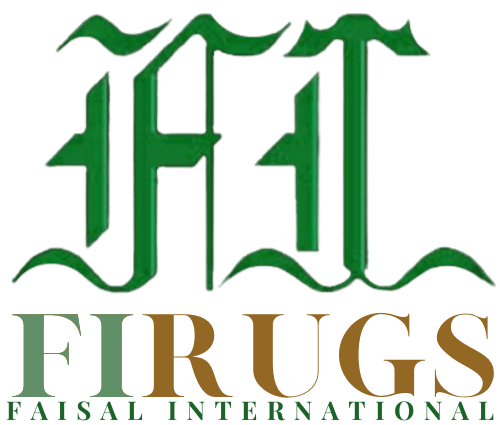
Table of Contents
TYPES OF RUGS EXPLAINED
Types of rugs, to begin with, we first categorize rugs in two parts.
- Rugs with a pile
- Rugs without a pile
Flatweave rugs have no pile. It means that the fibers are woven back & forth like in Native American carpets, or kilims from Iran or Turkey. The other ones like durries from India and Pakistan. They are all examples of flat-woven area rugs.
Rugs with piles can be either machine-made or handwoven. These rugs have a pile, which makes it the thickness of the carpet. They have the depth pile because of the way of the rug’s creation. They’ve done either by tying the knots by hand or by machine weave using a power loom. They have a proper thickness, so it’s called pile rugs.
Now within that, there are machine-made and handmade rugs.
Let us learn some of the types of area rugs one by one.
Different Types Of Rugs Construction
- Hand-knotted
- Hand-tufted
- Flatweave or Kilim or Dhurrie
- Handloom
- Machine-made
- Hooked Rugs
- Hide Rugs
- Braided Rugs
Different Area Rug Types Explained

HAND KNOTTED RUGS
Hand-knotted area rugs are those artfully woven rugs with different types of fibers of the most excellent quality of wool and silk. The knots(KPSI) make up thousands of knots tied on top of one over the other forming intricate designs. Hand knotted wool rugs are also the celebrity rugs as they are luxurious, royal-like, and most expensive rug types.
Hand-knotted rugs may take months to weave a single piece of average rug size with the average number of KPSI.
Various types of Persian rugs, hand-knotted, are a significant investment that gets more precious with time. The older they get, the more valuable they become. The cost is high basically of the length of time, the physical effort, and the scarcity of laborers for developing these rugs.
Another thing that adds to the real beauty of it is that no two hand-knotted rugs can be an exact duplicate. Why? It’s because they are not machine made and do not follow an automated regular sequential pattern of weaving. Instead, hand-knotted rugs are ‘human hands’ made.
Oriental rugs are the most expensive rugs out of all other types of rugs, and there are many types of oriental rugs made in India. They have more dense designs in them, and they are handmade well as machine-made. Consider the one made in original silk and handpick them by visiting the rug store.
Helpful Tip
If you notice any fiber popping out on the rug’s surface, do not pull it. Pulling it can ruin the carpet. Instead, cut the thread with a pair of scissors. Popping out of a thread in a rug is a common issue with every hand-knotted rug.

HAND-TUFTED RUGS
Tufted rugs form by using a small gun like a tool called a ‘tufting gun.’ They follow a completely different weaving technique by punching strands of silk or wool on a cloth canvas stretched on a metallic frame. Sometimes at first glance, people mistake tufted carpets for hand-knotted carpets. To determine the difference between hand-knotted and tufted carpets, look at their back. Unlike hand-knotted area rugs, tufted rugs have white latex canvas back with no trace of wool knots.
Latex is a sticky solution applied to the backside of tufted rugs to keep the wool fixed together.
These are stylish, budget-friendly, and affordable wool pile rugs. They go well with great interiors. They are perfect for areas with heavy traffic like hall entryways, living rooms, etc.
Helpful Tip: One of the drawbacks of tufted rugs is that they shed. The shedding lessens with periodic vacuuming over time. Remember -these rugs have a pile, meaning that the rug’s placement and the amount of foot traffic it gets can affect the amount of shedding.
Durability
These types of rugs are durable up to 5-10+ years. The rug’s strength depends on the quality and the material used by the carpet manufacturer.
Cleaning
We recommend vacuum tufted rugs rather than water wash. It is because of the latex used on the canvas, which may lead to loosening of the wool.
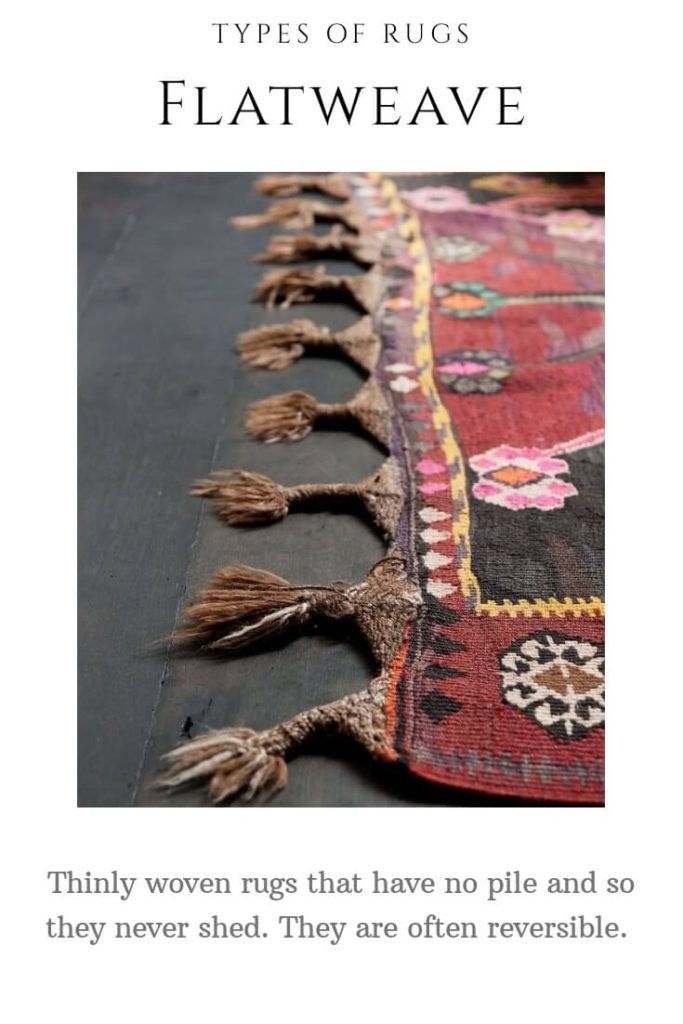
FLATWEAVE RUGS
These are the same as Kilim rugs or the Dhurrie rugs. Flatweave rugs have no pile, so they also don’t shed. You will find them crafted on a loom rather than hand-knotted. The weaving is by interweaving warp(length) and weft(width) threads. This technique of weaving makes the rug quite thin and highly exquisite.
About Dhurrie rugs, this is not it. Unlike pile carpets, flatweave rugs are reversible. The design patterns on both sides of the carpet are the same in most cases. They are reversible, which means that you can use either side of the flat-weave rugs as and when needed.
Most flat weave or kilim rugs follow a geometrical and diagonal design pattern. These cost low and affordable rugs. They very much preferred for flooring from bathrooms to kitchens.
Wool is the most essential and the primary material used to make a flat weave rug. Most flatweaves use wool for the warps and wefts, or both. Wool is the necessary weft material used with cotton warps. The other materials used instead of wool is the art silk.
Helpful Tip
Since flat woven area rugs are skinny, it’s essential to put a rug pad at the bottom. Placing a rug pad will help restrict the carpet from moving from its original place.
Difference between Flatweave, Kilim and Dhurrie Rugs
The fundamental difference between a flatweave, kilim, or dhurrie rugs is only the difference in their names. Some rug importers call it kilim, the word coming from the tribal side. Some call it Dhurrie, as Indians know it well by this name. In modern times, the west calls it Flatweave.

HANDLOOM RUGS
Handloom carpets are hand-knotted carpets in three different styles. It is an alteration of knots and wefts. Here the knots wrap around the warps. Handloom carpets are one of the most affordable types of rugs. They are simple to maintain and keep clean.
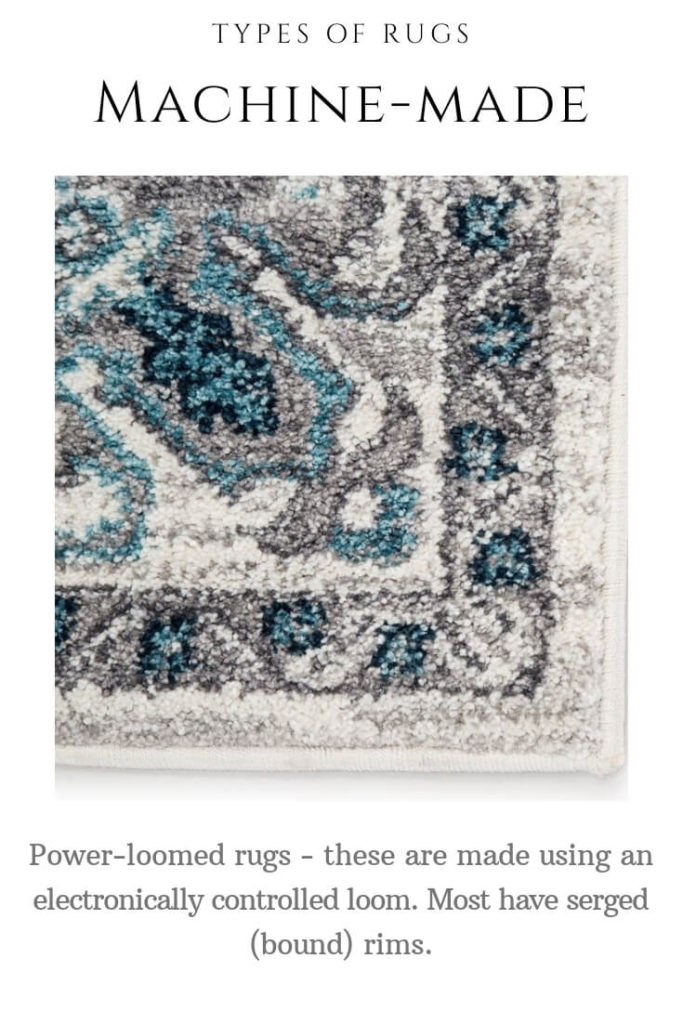
MACHINE-MADE RUGS
They are machine woven rugs by heavy electrical machines. These powered looms run on electronic computers following a sequence-wise format for rug development. Unlike handwoven rugs, machine-made carpets take lesser time in the making of the rug. The material used in the manufacturing of these types of rugs differ. They are usually blended wool with synthetic fibers like polypropylene, nylon, and other materials like polyester, art silk, and acrylic.
There is a reason why machine-made rugs use blended wool with synthetic for carpet making. Pure wool alone is a weaker fiber, while synthetics are potent. When these two blends, they become soft and firm as well. Hence, power looms are not interrupted by the material thread breaking now and then. Otherwise, wool alone is an issue during the machine weaving process.
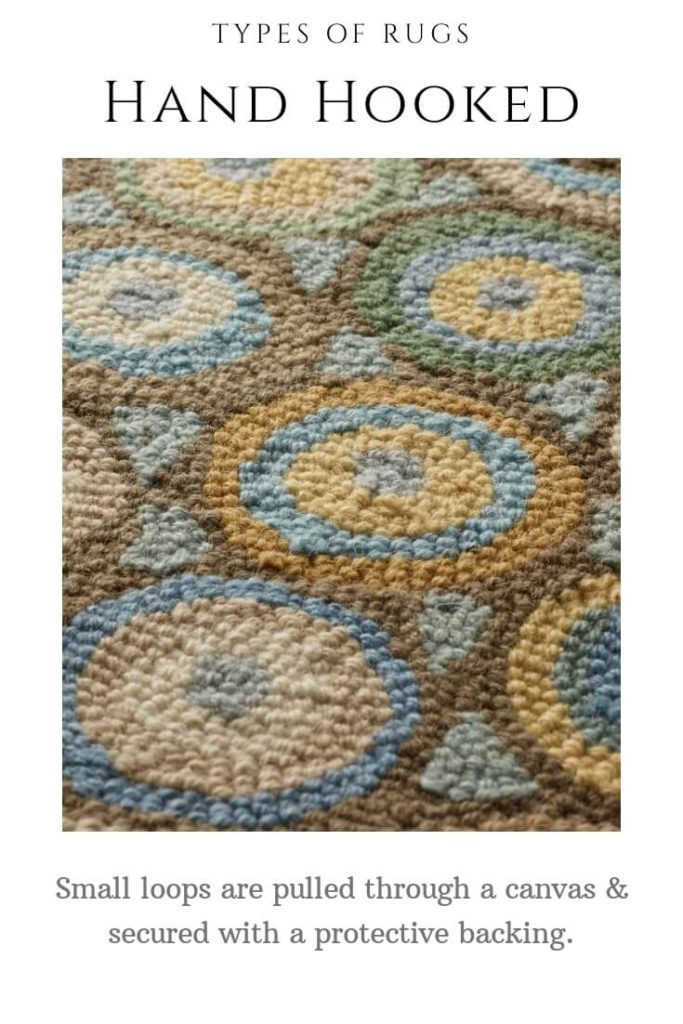
HOOKED RUGS
Hooked rugs are handmade using a needle-like tool. They are woven on a canvas and have a backing that supports the design stay together. They are inexpensive and trendy types of rugs.
Helpful Tip
Shedding and popping of fiber are quite common. Prevent from pulling any popping out strands. Instead, cut it or snip it. Vacuuming hooked carpets by itself reduces the shedding over time. Place the rug where it gets less foot traffic as it affects the shedding.
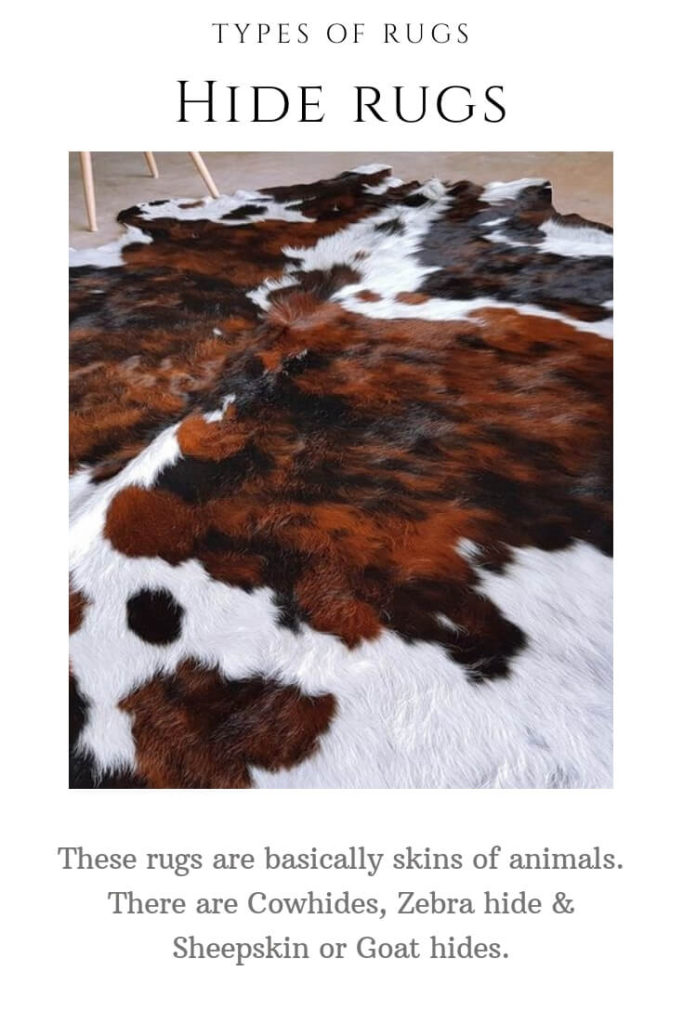
HIDE RUGS
Hide rugs are neither handmade nor machine-made. Then what are they? Well, they are the outer skin of animals. Every animal’s skin has a unique pattern and texture on them, and this is all that makes them beautiful.
The skin goes through different processing so much so that it is only the leather and the furs. Some of the popular types of hide rugs are sheepskin, goat hide, deer hide, zebra hide, and cowhide.
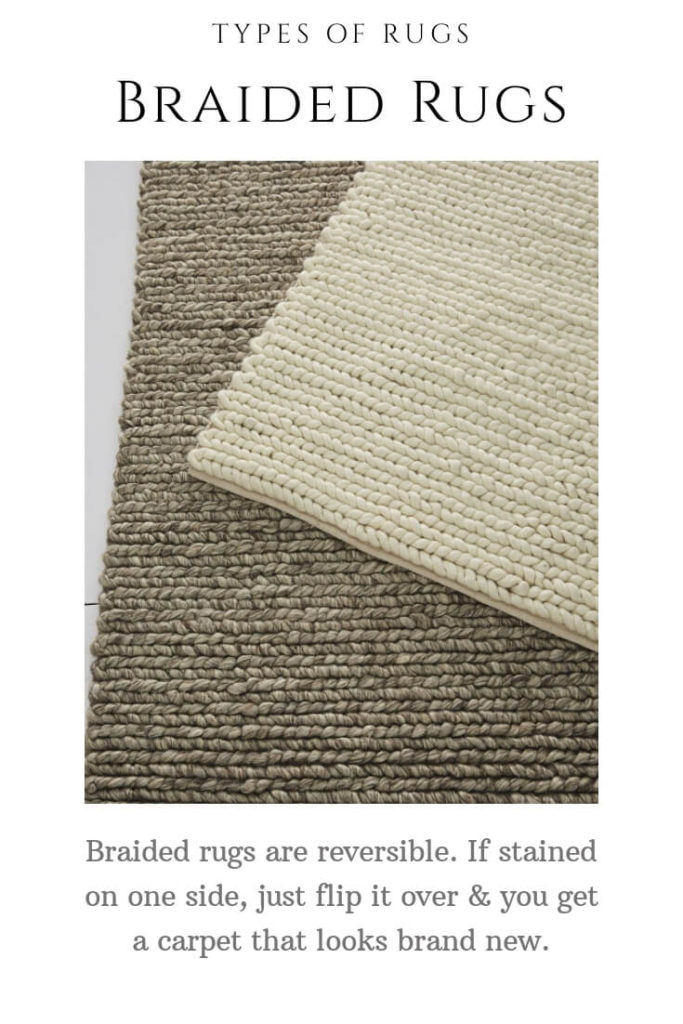
BRAIDED RUGS
The making of braided rugs is by tying pieces of fabric strips together. The fabrics may range from cotton to wool. Their thickness may differ. Are you wondering what decor they can match up? Well, they are great for country home decor and traditional decor as well.
Another advantage of braided carpets is that they are reversible. If the rug gets dirty, the other side can come in use. They also come in oval and round shapes and various sizes.
Types Of Rugs By Shape
Shapes of your rug can change the whole look of your interior. What shape rug your space has to have either a personal preference or what your home decor needs.
You can categorize rugs in different sizes and shapes. There are all sizes and shapes of rugs for every room. Generally, living room rugs are large, and bedroom rugs smaller. For the kitchen, going with a runner rug is more preferred. Bathroom rugs are as small as 3×2 size.
There are usually three shapes of rugs as below.
RECTANGLE
Rectangular shape rugs are the most common of all the rug shapes. These rugs can size from as small as 2×3 to as huge as 9×12 and more.
Runner rugs are the narrow rugs with short width and very long length. The runner is rugs that are perfect for placing in the kitchens, hallways, and any confined spaces.
SQUARE
Any room that is in the shape of a square can go with a square-shaped rug rather than a rectangular. You will notice with square rugs that they have a square coffee table on them. That is how significant shapes have over home decorations.
ROUND
Round shapes rugs find their importance. Round rugs can have the pattern and design that rectangle and square rugs have. Round Persian rugs look equally as elegant as other shapes.
Round jute rug is the trend these days. Try placing one of them in the center of your staircase hall; they are an eye stealer.
The other popular shapes that play around with the decor are Hexagon, Pentagon, Animal skin pattern shape, and others. Any there are any out of the box shapes, discussing with a custom rug manufacturer can get it done.
Types Of Rugs By Pattern
Rug’s pattern is another essential factor that counts while buying a new carpet. A wrong rug pattern can pull down the entire decoration plan. So fashion your space according to decor elements already within the area.
Some of the basic patterns are:
GEOMETRICAL PATTERN
These rugs mostly have geometric designs like Trellis, Quatrefoil, Polka dots. Modern contemporary rugs follow this very pattern.
FLORAL
Florals rugs have designs with flowers, leaves, buds, and branches. Persian oriental carpets follow this design pattern.
SOUTHWESTERN PATTERN
Southwestern rugs, started by the native Americans, tell the story of Americans at the early stages of their development. Why not show off your patriotism by displaying it in your living room with these great carpets from the Southwest!
Type Of Rugs By Colors
Do we even need to discuss how, why, and what role colors have in transforming any interior!
Are you finding it difficult to choose the right color? It is easier than you might think. Your space can, by itself, tell what color rug to pick.
Usually, a rug is the last thing installed after a room’s finish. The walls have the paint on them, the curtains installed, wall frames hanging, and the furniture with cushions all in its place.
To choose a color for your interior, simply run your eyes all around the entire room. Take the bits of colors from the primary colors and bits from the other matchings.
Rugs By Materials
Which are the best materials for area rugs?
By far, high quality wool is considered the best material for rugs and the original forms of making carpets and rugs.
Do you know what is the most durable rug material? Yes, wool again. They can last for a century and more if taken good care.
Rugs made in pure wool are costlier yet more durable compared to other rug fibers.
Cotton Vs. Wool Rugs
Rugs By Texture
A rug and carpet can have textures way different from each other. The difference can be determined based on their weaving, feel and appearance.
Some of the texture are, cut pile, loop pile, frieze, plush, etc. Click to know more about types of carpet textures in detail.
FQAs About Types Of Rug
What Kind Of Rug Do I Have?
The rug type you need depends on the place of placement, for interior or outdoor. Outdoor rugs are of nylon or plastic that easily bear the weather. Indoor rugs need to match the color of the interior. Pick the right size and material that fits in your budget. To know about the type of rug you own, share the image of it with Faisal International.
What Types Of Rugs For Bedroom?
Any rug that suits your eyes or pleases you go for it. It’s more about a personal choice of the color, the rug’s pattern, or the design. Yet, all you should consider is the size of the bed. Queen bed rugs are large, and king sizes are larger.
Choose the correct rug size for your bedroom. If you have a reasonable budget, then no doubt go with hand-knotted woolen rugs. While woolen area rugs are luxurious, flat weaves are beautiful and inexpensive. Bamboo silk area rugs are an excellent alternative to real silk rugs. Next, match the colors with the wall color, curtains, furniture, and the bed itself.
What Are The Best Types Of Rug Weave?
Some of the most popular types of rug weaving are:
Flatweave
Hand-knotted
Hand-hooked
Hand-tufted
Shag(or shaggy)
Machine-made
What Are The Types Of Rugs Materials?
There are a variety of fibers that make different types of area rugs. Some materials are natural, while some are synthetic and some blend. Some natural fibers are wool, real-silk, cotton, jute, sisal, and seagrass.
They also include leather, faux fur/faux hide rugs. Some unnatural rug materials are like viscose, polypropylene, microfiber/polyester rugs, nylon, etc.
What Are Some Types Of Handmade Rugs?
Handmade rugs are all those rugs, the making of which is by using human hands and not machines. Some handmade rugs are hand-knotted, tufted, handloom, flatweave(or kilim) & braided rugs.
What Rug Materials To Avoid?
What rug material to take and what to avoid can depend upon different factors. For high foot-traffic areas, avoid avoiding fiber rugs like art silk(rayon or viscose). For outdoors and bathroom flooring, go with nylon rather than wool. Avoid material like jute or viscose from wet places. Some might be allergic to synthetic fiber, as they may have been treated with chemicals. So better avoid if you or someone in the family is suffering from these issues.
What Are Some Types Of Flatweave Rugs?
Flatweave rugs are inexpensive and come in a variety of materials. They are lightweight, easy to clean. They do not have a pile, and henceforth they never shed. Some of the categories of flatweave rugs are needlepoint rugs, hooked rugs, Panja dhurrie rugs, Aubusson, & chain stitch rugs.
What Are Wool Rugs?
Among all different kinds of rugs, wool rugs are the original form of them and have thousand years of history. This fiber, obtained from sheep, is a natural fiber. They are easy to clean. If taken good care of, they can last for more than fifty to a hundred years. These days wool rugs come with other synthetic fiber blends. Blended fibers make carpets and rugs inexpensive yet durable.
What Are Some Expensive Rug Types?
There are two ways to determine the cost of a rug. It’s either by the type of fiber used in making it or, by the quality(KPSI) of the rug. For instance, real-silk fiber rugs are costly. New Zealand wool is the finest wool amongst other wool types.
Higher the quality of a rug, the more top it costs. Hence, this means more time and labor put in making high-quality rugs. Some high quality hand-knotted regular size rugs may take 6-8 months to produce them.
What Are Some Types Of Rug Piles?
Pile of a rug refers to the density of the fiber in a carpet. In other words, it is the thickness of the rugs. Within that, a carpet can be a high pile or a low pile. Handwoven or hand-knotted rugs have a pile in them while flatweave or kilim or hurry rugs have no pile.
We hope you have got our types of rugs guides helpful. For any queries for discussion, please contact us.
GOOD LUCK WITH YOUR HOME FLOORING
